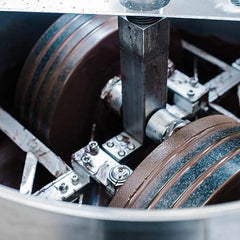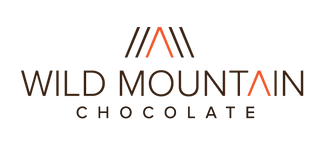Grown in equatorial areas, our cocoa pods are handpicked and dried on the ground under the warmth of the sun.
After their long journey abroad, the beans make their way into our Invermere-based chocolate shop. The cocoa beans are roasted with shells on and are then transferred to the grinder, where they spend two to three days to get below 20 micron in size.
This process adds heat to the bean, allowing them to off-gas.
“It’s a balance,” explains chocolate maker Glen Davies. “We want to ensure that the bean doesn’t lose good acids and flavours during this process.”
With machinery that has been imported from Italy, Glen says that while the equipment is complex — he doesn’t approach chocolate making like a scientist, rather like an artist.
The roaster has a 30-kilogram capacity – which is controlled by software to ensure the perfect roast every time.
Good Chocolate Takes Time
Each batch takes three to four days from start to finish, which results in consistent and creamy batches of wild and tasty chocolate.
As one of the only bean-to-bar manufacturers in Western Canada, Wild Mountain Chocolate is a large-scale production that promotes sustainable cacao farming methods globally.
“The longer you take to make it, the better the chocolate is,” explains Glen of the meticulous process.
Have a Taste
Wild Mountain Chocolate uses 100% organically sourced cocoa beans, and our chocolates contain two simple, dynamic ingredients: cocoa beans and sugar.
The origin of the bean — the growing climate, the harvesting method and the production process is where you achieve the flavour and texture.
If chocolate is tempered properly, it doesn’t melt in your hand,” says Glen. “It’s about mouth feel.”
When delving into your own bar of Wild Mountain Chocolate, use all six tasting zones on your tongue, swirl it in your mouth and then add air by breathing in through your mouth and then out through your nose. What do you taste?
Each bar we make has a story, following a process that takes over 3 months from the day it was harvested to the day it touches your tongue - a story that we'd love to share with you!
-

Harvesting
Our chocolate bars have a long an storied journey starting at our organic farms, where the cacao trees produce the cacao fruit - a large, colourful pod that looks a little like a football. These pods are cracked open revealing the cacao beans, which are coated in a white sweet tasting pulp. -

Fermentation
The whole beans, including pulp (which fuels the fermentation), are covered and left to naturally ferment. This is the first step in the process which creates the complex flavour of chocolate, during which many alchemical processes happen - but in the end, no alcohol remains. Sadly. -

Drying
At just the right moment our beans are removed from the fermenters and dried naturally. The beans are laid out on a large flat surface where the sun and the breeze can begin to whisk away moisture (stoping the fermentation process). This can be a very time consuming task, requiring constant attention. -

Transport
The dried fermented beans are then rigorously tested by the quality assurance team to remove 'flat' beans, impurities, and the like, before being sorted and bagged. These bags of raw beans are then shipped directly to us, where we are tasked with turning them into chocolate, right here in Canada. -

Sorting
Once the raw cacao beans arrive in our shop, we roll up our sleeves and begin the process of sorting (again). Our commitment to quality demands that we hand select only the best beans - a process which is time consuming - but essential for creating a regionally distinct chocolate.
-

Roasting
Roasting is a fine art, and is one of the primary steps in developing the rich and unique flavours of our chocolate. Each regional bean has it's own personality, and needs to be roasted in it's own special way to bring out it's unique characteristics. We want you to taste the distinct characteristics of each region as it manifests in our bars.
-

Cracking
After roasting, we have a dark aromatic bean (it fills the entire shop with a rich, warm smell), but for chocolate making what we're really after is the nib which we get by gently crushing each bean. These nibs are edible, and quite delicious - if you don't mind the natural bitterness!
-

Winnowing
Winnowing separates the crushed cacao nibs from the husk (or outer skin, if you will). By using air currents and a specialized piece of equipment we separate and remove the husk, which could add undesirable flavours if left in. After winnowing, we're left with pure crumbled cacao nibs which move directly into the melangeur!
-

Grinding
At Wild Mountain Chocolate we use what's called a melangeur - large granite wheels - to grind the nibs. The cacao is so finely ground over such a long period of time that your tongue cannot detect individual particles, giving our chocolate a smooth, creamy finish.
-

Conching
This process takes the cacao liquor produced during the friction of grinding and works to develop the flavours even further. Over the course of many days, the liquor is agitated, aerated and heated under specific conditions to remove bitterness, enhance traits, and to fully mix the liquor.
-

Tempering
A quality chocolate is often defined by it's presentation; a bar with a distinct 'snap', that doesn't melt in your hand, and has an attractive glossy finish, are all indicators of quality. Tempering is the finicky process by which this is achieved - the development of a fine crystalline structure in the chocolate by carefully heating and cooling it. -

Molding
Once the perfect tempering has been achieved, the chocolate is immediately deposited in the mold and left to cool in our air conditioned storage room. After it has sufficiently hardened it is removed from mold, and proceeds to the next step... With a little taste testing here and there.
-

Packaging
The finished bars are then wrapped and placed in their packaging, before being shipped around the world for chocolate lovers to enjoy. Each of our Wild Mountain Chocolate bars embarks on a wild journey; from the day the cacao bean was harvested to the moment it's wrapped and boxed. We hope each bar enriches your life!














